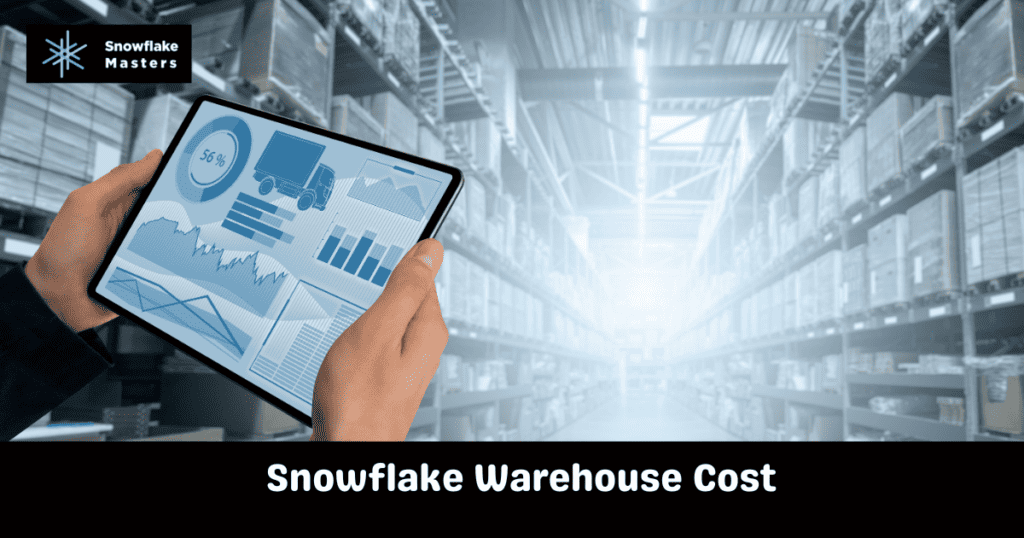How to Calculate Your Snowflake Warehouse Cost: A Step-by-Step Guide
Snowflake Warehouse Cost

Snowflake is a cloud-based data warehousing platform that has gained popularity recently due to its scalability, flexibility, and ease of use. However, one of the biggest concerns for many businesses is the cost of using Snowflake.
This article will guide you using the step-by-step procedure of calculating your Snowflake warehouse cost. We will also provide relevant statistics and diverse perspectives to help you optimise your data expenses and maximise ROI.
Table of contents
- What is Snowflake?
- what is a snowflake data warehouse
- snowflake storage cost
- How is the cost of storage calculated in Snowflake?
- snowflake warehouse pricing
- Understanding Snowflake Warehouse Cost
- Step-by-Step Guide to Calculating Snowflake Warehouse Cost
- Relevant Statistics on Snowflake Warehouse Cost
- Diverse Perspectives on Snowflake Warehouse Cost
- Conclusion
what is a snowflake data warehouse ?
Snowflake is a cloud-based data warehousing platform that allows businesses to store, process, and analyse large amounts of data. It is known for its scalability, flexibility, and ease of use, making it a popular choice for businesses of all sizes. Snowflake provides various features, such as automatic scaling, data sharing, and security controls, that make it a powerful and efficient platform for data warehousing.
One of the main advantages of Snowflake is its ability to handle large amounts of data cost-effectively. The platform offers pricing on a pay-as-you-go basis allowing businesses to only pay for the resources they utilise. Because it eliminates the need for firms to invest in costly hardware and software, it is a desirable option for business entities with limited IT resources.
Snowflake also offers a variety of integration options, allowing businesses to connect to other tools and services easily. That makes it easier for businesses to manage their data across different platforms and applications.
Snowflake is a powerful and efficient data warehousing platform that offers businesses a cost-effective and scalable solution for managing their data. Its ease of use and integration options make it a favourite choice for businesses of all sizes looking to streamline their data management processes.
Another key feature of Snowflake is its strong focus on data security and compliance. The platform includes robust encryption methods and access controls, ensuring that sensitive data is protected. Additionally, Snowflake complies with various industry standards and regulations, providing businesses with peace of mind regarding data privacy and protection.
Finally, Snowflake’s design allows for parallel workloads without decrease in performance. This means multiple teams can run queries and analyses simultaneously without slowing down the system. This capability is particularly beneficial for businesses with diverse teams that need to access and analyze data at the same time, enhancing collaboration and decision-making.
Snowflake storage cost
Snowflake storage cost is based on the amount of data stored in the platform. The cost of storage is determined by the storage tier that is selected, as well as the amount of data that is stored and the retention period. Snowflake offers several storage tiers, ranging from standard to premium, with varying levels of performance and redundancy.
The storage cost is calculated based on the amount of data stored per month, with prices ranging from $23 per terabyte per month for standard storage to $125 per terabyte per month for premium storage. The storage cost also includes a charge for data transfer, which is based on the amount of data transferred into and out of Snowflake.
Businesses can use Snowflake’s intelligent information tiering capability to save storage costs by automatically moving data throughout storage tiers according to consumption patterns. That allows businesses to store less frequently accessed data in lower-cost storage tiers while keeping frequently accessed data in higher-performance storage tiers.
Snowflake storage cost is based on the amount of data stored, the retention period, and the storage tier selected. By carefully evaluating their data storage needs and usage requirements, businesses can optimise their usage of Snowflake and ensure they get the most value out of their data expenses.
How is the cost of storage calculated in Snowflake?
The storage cost in Snowflake is based on several factors, including the storage tier selected, the amount of data stored, and the retention period. Snowflake offers several storage tiers, ranging from standard to premium, with varying levels of performance and redundancy. The storage cost is calculated based on the amount of data stored per month, with prices ranging from $23 per terabyte per month for standard storage to $125 per terabyte per month for premium storage.
In addition to the cost of storage, there is also a charge for data transfer based on the amount of data transferred into and out of Snowflake. This charge is typically minimal when compared to the cost of storage.
Businesses can optimise their storage costs by using Snowflake’s automatic data tiering feature. This feature automatically moves data between storage tiers based on usage patterns. That allows businesses to store less frequently accessed data in lower-cost storage tiers while keeping frequently accessed data in higher-performance storage tiers.
The cost of storage in Snowflake is based on the amount of data stored, the retention period, and the storage tier selected. By carefully evaluating their data storage needs and usage requirements, businesses can optimise their usage of Snowflake and ensure they get the most value out of their data expenses.
Snowflake warehouse pricing
The platform offers pricing on a pay-as-you-go basis allowing businesses to only pay for the resources they utilise. The pricing is based on several factors: storage, computing, and data transfer.
The cost of storage in Snowflake is determined by the storage tier selected, the amount of data stored, and the retention period. The cost of computing is based on the virtual warehouse size selected, the number of nodes, and the usage time. Data transfer costs are based on the amount of data transferred into and out of the platform.
Snowflake offers several virtual warehouse sizes, ranging from X-Small to 4X-Large, with prices ranging from $2 to $64 per hour. Businesses can scale up or down their virtual warehouse size to better align with their usage needs.
In addition to the virtual warehouse size, businesses can select a performance level for their virtual warehouse, ranging from Standard to Enterprise. The performance level determines the concurrency and query performance level that is available.
Snowflake warehouse pricing is based on a flexible and scalable model that allows businesses to pay only for the resources they use. By carefully evaluating their usage needs and selecting the appropriate storage, computing, and performance levels, businesses can optimise their usage of Snowflake and ensure that they are getting the most value out of their data expenses.

Understanding Snowflake Warehouse Cost
Understanding the cost of using Snowflake is essential for businesses that want to optimise their data warehousing expenses. The cost of using Snowflake is based on several factors, including storage, computing, and data transfer. The platform offers pricing on a pay-as-you-go basis allowing businesses to only pay for the resources they utilise.
Businesses need to identify their storage, calculating, and data transition requirements to calculate the cost of applying Snowflake. This involves calculating the amount of data that needs to be stored, the amount of compute resources required to process the data, and the amount of data that needs to be transferred into and out of Snowflake. Once these factors have been determined, businesses can use the Snowflake pricing calculator to estimate their monthly costs.
It is important for businesses to carefully consider their data warehousing needs and usage requirements when evaluating the cost of using Snowflake. For example, businesses that require high computing resources may need to choose a larger virtual warehouse size, which can increase their costs. Similarly, businesses that need to transfer large amounts of data may need to choose a more expensive data transfer pricing plan.
Understanding Snowflake warehouse costs requires careful consideration of several factors, including storage, computing, and data transfer. By carefully evaluating their data warehousing needs and usage requirements, businesses can optimise their usage of Snowflake and ensure they get the most value out of their data expenses.
Step-by-Step Guide to Calculating Snowflake Warehouse Cost
Here is a step-by-step guide on how to calculate your Snowflake warehouse cost:
Step 1: Determine your storage needs
- Calculate the amount of data that you need to store in Snowflake
- Determine the storage tier that you need based on your data size and retention requirements
Step 2: Determine your computing needs
- Determine the amount of computing resources that you need to process your data
- Choose the appropriate virtual warehouse size based on your workload requirements
Step 3: Determine your data transfer needs
- Calculate the amount of data that you need to transfer into and out of Snowflake
- Choose the appropriate data transfer pricing plan based on your usage requirements
Step 4: Calculate your Snowflake warehouse cost
- Use the Snowflake pricing calculator to estimate monthly costs based on your storage, computing, and data transfer needs.
Relevant Statistics on Snowflake Warehouse Cost
According to a report by 451 Research, Snowflake has a lower total cost of ownership than on-premises data warehousing solutions. The report found that Snowflake’s cloud-based approach can save up to 60% of the cost compared to traditional data warehousing solutions. That is because Snowflake eliminates the need for businesses to invest in hardware, software, and maintenance costs associated with on-premises solutions.
Additionally, Snowflake offers various pricing plans allowing businesses to choose the plan that best suits their requirements. According to a survey by TechValidate, 77% of Snowflake users reported that they are satisfied with the pricing and licensing model offered by the platform.

Diverse Perspectives on Snowflake Warehouse Cost
While Snowflake is known for its scalability and flexibility, some businesses have raised concerns about the platform’s cost. According to a survey by TechValidate, 34% of Snowflake users cited cost as a top challenge when using the platform. However, many businesses have found that the benefits of using Snowflake, such as improved performance and faster time-to-insight, outweigh the costs.
It is important for businesses to carefully consider their data warehousing needs and usage requirements when evaluating the cost of using Snowflake. By following the step-by-step guide in this article, businesses can better understand their data warehousing costs and make informed decisions about optimising their usage of Snowflake.
Conclusion
Calculating your Snowflake warehouse cost is essential to ensuring you get the most value out of your data expenses. By following the step-by-step guide in this article, businesses can better understand their data warehousing costs and make informed decisions about optimising their usage of Snowflake.
While cost may be a concern for some businesses, the benefits of using Snowflake, such as improved performance and faster time-to-insight, make it a valuable investment for many companies.
FAQ’s
The cost of using Snowflake is based on several factors, including storage, computing, and data transfer.
The storage cost in Snowflake is based on the storage tier selected, the amount of data stored, and the retention period.
The cost of computing in Snowflake is based on the virtual warehouse size selected, the number of nodes, and the usage time.
The data transfer cost in Snowflake is based on the amount of data transferred into and out of the platform.
You can estimate your Snowflake warehouse costs using the Snowflake pricing calculator and inputting your storage, computing, and data transfer needs.
A virtual warehouse in Snowflake is a compute cluster that provides processing power for queries and data transformations.
You can optimise your Snowflake warehouse costs by carefully evaluating your data warehousing needs and usage requirements, using automatic data tiering, and selecting the appropriate storage and compute tiers.
Automatic data tiering in Snowflake is a feature that automatically moves data between storage tiers based on usage patterns.
Yes, you can change your Snowflake warehouse size anytime to better align with your usage needs.
Snowflake’s pay-as-you-go pricing model means that businesses only pay for their resources based on hourly usage and data storage.
